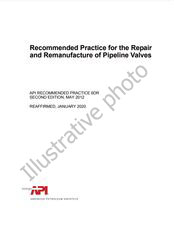We need your consent to use the individual data so that you can see information about your interests, among other things. Click "OK" to give your consent.

API PUBL 4640-ed.1997
Petroleum in the Freshwater Environment an Annotated Bibliography 1946 - 1993
Translate name
STANDARD published on 1.3.1997
The information about the standard:
Designation standards: API PUBL 4640-ed.1997
Publication date standards: 1.3.1997
SKU: NS-1139806
The number of pages: 211
Approximate weight : 664 g (1.46 lbs)
Country: American technical standard
Category: Technical standards API
Annotation of standard text API PUBL 4640-ed.1997 :
API PUBL 4640, 1997 Edition, March 1997 - Petroleum in the Freshwater Environment an Annotated Bibliography 1946 - 1993
Research on the fate and effects of spilled petroleum products has traditionally focused on estuarine and marine ecosystems. The perception of these habitats as being at risk from petroleum contamination stems from the occurrence of major spills over open seas or at coastal terminals during transportation of crude oils and refined products. However, many petroleum-handling facilities are located near freshwater ecosystems (e.g., rivers and lakes) through which petroleum products are transported.
Between 1977 - 1982, data compiled by the United States Coast Guard on discharges of oil and hazardous substances in and around the nations waters (Pollution Incident Reporting System, PIRS) show that "inland" oil spills have regularly constituted more than 25 percent of spill events (USCG 1977 - 1982). Between 1983 and 1992, more than 30 percent of the spills occurred in coastal waters within 12 miles of U.S. shores; another 42 percent occurred in inland bodies of water. The rest occurred in other bodies of water under U.S. jurisdiction. In addition, the amount of petroleum hydrocarbons entering surface waters from industrial and municipal effluents and urban runoff has also been substantial (Hoffman et al., 1982, 1983; Mackenzie and Hunter, 1979; Van Vleet and Quinn, 1977; Whipple and Hunter, 1979).
The growing concern for petroleum contamination in freshwater ecosystems led API to update this annotated bibliography. The document is designed to serve as a valuable resource of existing literature on petroleum and its impact on the freshwater environment. The companion infobase version of this bibliography has been prepared to enhance the value of the annotations for the reader. Infobase diskettes accompany this report.
This document is a compilation of literature citations concerning the impact of petroleum and petroleum-related compounds on the freshwater environment. The annotated bibliography cites literature from 1946 through 1993. It was derived from three literature reviews completed for API: one in 1984, by the Academy of Natural Sciences of Philadelphia; and a second in 1994, by Woodward-Clyde Consultants; and a third in 1995, by ENSR Consulting and Engineering.
The citations in this bibliography were obtained through the use of computerized literature-searching services with access to both DIALOG and ORBIT bibliographic retrieval systems. Additional citations were obtained from literature cited in publications that were reviewed. In addition, a substantial number of documents were provided by API members.
The review was limited to the impact of specific petroleum products (crude oil, fuel oils, kerosene and gasoline) and oil spill cleanup agents on the biota of freshwater ecosystems; the chemistry and fate of petroleum and cleanup agents in freshwater; and a review of cleanup methods in freshwater systems. These subjects were used to screen articles for inclusion in the bibliography. Criteria for deleting references included papers published before 1946; marine or estuarine studies; citations pertaining to individual components of petroleum products such as xylene, naphthalene or benzene; studies on oil refinery effluents; environmental impacts of oil-sand and oil shale processing; or impacts of oil exploration.
The references in the annotated bibliography are organized by the following categories: general, introduction, chemical and physical aspects of petroleum, rivers, lakes, wetlands, soils, organism type, and spill cleanup. Citations are listed alphabetically, by first author, within each category. The annotation provided for each citation includes, but is not limited to, the research topic, organisms studied, habitat and whether the study was conducted in the field or the laboratory.
We recommend:
Updating of laws
Do you want to be sure about the validity of used regulations?
We offer you a solution so that you could use valid and updated legislative regulations.
Would you like to get more information? Look at this page.



 Cookies
Cookies
